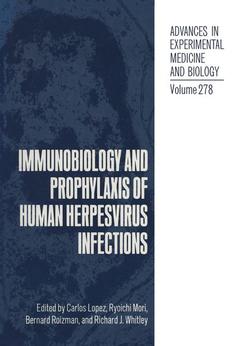Description
Immunobiology and Prophylaxis of Human Herpesvirus Infections, Softcover reprint of the original 1st ed. 1990
Advances in Experimental Medicine and Biology Series, Vol. 278
Coordinators: Lopez Carlos, Mori Ryoichi, Roizman Bernard, Whitley Richard J.
Language: English
Subjects for Immunobiology and Prophylaxis of Human Herpesvirus...:
Keywords
development; immunobiology; infection; infections; virus; infectious diseases
Publication date: 03-2012
306 p. · 17x24.4 cm · Paperback
306 p. · 17x24.4 cm · Paperback
Description
/li>Contents
/li>
No one whose opinion deserves a moment's consideration can doubt that most of the great positive evils of the world are in themselves removable, and will, if human affairs continue to improve, be in the end reduced to narrow limits. J. S. Mill, Utilitarianism, II, 1863 Mill was not writing about herpesviruses, but had he known them as we do, he would have included them among the great positive evils of the world. They cause disease and premature death, and are very costly to our society. There is no loftier aim than to cure or prevent human infections with these viruses. The objective of much of the current research on herpesviruses is directed toward an understanding of the molecular mechanisms involved in initiation of infection, establish ment and termination of latent state, virus multiplication, and the destruction of cells which ultimately is the basis of the diseases caused by these viruses. At no time during the past 80 years, since members of the herpesvirus family were first discovered, has there been so much progress in our understanding of the biology of these viruses as in the past few years. Along with the development of a greater understanding of the molecular biol ogy of the well-known herpesviruses we have witnessed the isolation of new human herpes viruses.
Human Herpesvirus No. 6.- Cellular and Growth-Factor Requirements for the Replication of Human Herpesvirus 6 in Primary Lymphocyte Cultures.- Genomic Heterogeneity of Human Herpesvirus 6 Isolates.- Replication of Human Herpesvirus 6 (HHV-6): Morphological Aspects.- Exanthem Subitum and Human Herpesvirus 6 (HHV-6) Infection.- Viral Pathology of Human Herpesvirus 6 Infection.- Immunobiology of Varicella-Zoster Virus.- A Live Varicella Vaccine.- Differentiation between the Oka Varicella Vaccine Virus and American Wild-Type Varicella-Zoster Virus (VZV).- The T-Lymphocyte Response to Varicella-Zoster Viral Proteins.- A Possible Role for Glycoprotein gpV in the Pathogenesis of Varicella-Zoster Virus.- Human Cytomegalovirus.- Changes in the Epidemiology of Cytomegalovirus.- Antiviral Activities of a Human Monoclonal Antibody against Human Cytomegalovirus.- Epstein-Barr Virus.- Topological Effects of EBNA 1 on oriP.- Detection of 12-o-Tetradecanoylphorbol-13-Acetate-induced Cellular Proteins That Compete with the Epstein-Barr Virus Nuclear Antigen 1 (EBNA-1) for Binding to a Site within the Epstein-Barr Virus oriP.- On the Biology of Epstein-Barr Virus Persistence: A Reappraisal.- Epstein-Barr Virus, Burkitt’s Lymphoma, and an African Tumor Promoter.- Herpes Simplex Virus.- Regulation of Expression of the Glycoprotein Genes of Herpes Simplex Virus Type 1 (HSV-1).- Antigenic and Structural Properties of Mutants in Herpes Simplex Virus 1 Glycoprotein B.- Yeast-derived Glycoprotein B-1 of Herpes Simplex Virus (HSV) as a Candidate for an HSV Vaccine.- Herpes Simplex Virus Type 1 Infection in Mice with Severe Combined Immunodeficiency (SCID).- Herpes Simplex Virus Latency.- Transcripts Associated with Herpes Simplex Virus Latency.- Pathogenesis and Latency of Herpes Simplex VirusType 1 (HSV-1): An Ophthalmologist’s View of the Eye as a Model for the Study of the Virus-Host Relationship.- Mechanisms of Restriction of Viral Gene Expression during Herpes Simplex Virus Latency.- Diagnostics.- Detection of a Highly Conserved Region of Herpesviridae DNA by In Vitro Enzymatic Amplification: Application to the Detection of a New Human Herpesvirus.- Prevalence of Specific Antibodies to Herpes Simplex Virus Type 2 as Revealed by an Enzyme-linked Immunoassay and Western Blot Analysis.- Chemotherapy of Herpesvirus Infections.- Acyclovir: The Past Ten Years.- Brovavir: Its Antiherpesviral Activity and Mode of Action.- A Double-Blind Clinical Study in Patients with Herpes Zoster to Establish YN-72 (Brovavir) Dose.- (S)-1-(3-Hydroxy-2-(phosphonylmethoxy)propyl)cytosine (HPMPC): A Potent Antiherpesvirus Agent.- Conclusions.- Whither Herpesviruses?.- Author Index.
© 2024 LAVOISIER S.A.S.




